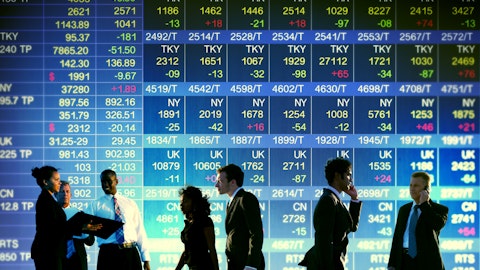In this piece, we will take a look at the 10 best materials stocks to buy according to hedge funds.
When compared to high growth technology stocks, materials stocks are among the most stable ones on the market. These are often sizeable firms whose performance is tied to the broader economic output. As a result, materials stocks offer investors a chance to ensure that their investments are not affected by the pitfalls of volatility that often accompanies high growth stocks. This volatility is often present in high growth sectors where firms face low barriers to entry, a high level of product diversification from peers which leads to more competition, and even though metals stocks fluctuate with the economy, their sizeable nature and high investment requirements mean that once they’ve set up shop, they can benefit from somewhat assured demand.
At the same time, their sizeable business operations also make materials stocks pay out handsome dividends. We took a look at some such stocks as part of our coverage of 12 Best Materials Dividend Stocks To Buy Now. Within this list, the top hedge fund materials dividend stocks had a dividend yield that ranged between 0.68% to 5.28%. The average dividend yield was 2% while the median yield among the 12 materials stocks was 1.88%. The top materials dividend stock, which had a yield of 5.28% ranked at 9th place, and it is one of the biggest chemicals companies in the world.
To analyze materials stocks’ performance and see what the future might hold for them, a relevant approach is to check how the commodities market is performing. Broadly speaking, materials stocks can be divided into those that sell construction materials and those that deal in metals. Starting from construction materials, the broader construction industry’s performance right now is somewhat mixed. The turmoil in the office real estate sector, driven by high interest and vacancy rates, continues to threaten contagion. Similarly, while the status of the residential sector isn’t as troubling, higher rates have created some interesting trends. Median housing prices in America soared to a record high of $419,300 in May; however, at the same time, housing supply also grew to 1.28 million to mark an 18.5% annual growth. Higher rates lead to homeowners forking out more for their property, and data from Redfin shows that the value of US homes soared to $47.5 trillion by December 2023.
Overall, US construction spending fell by 0.1% in May to sit at $2.1 trillion. For materials stocks, a slowdown means that their share prices are depressed. However, when compared to other markets, such as agriculture, not all is doom and gloom in construction. Industrial construction for warehouses boomed in 2022 and tapered off in 2023 due to high interest rates. Now, the Dodge Momentum Index, which measures non residential building project planning, increased by 2.7% to 179 in May. However, this, like the broader industry, also came with a caveat. Sequentially, data center construction planning spurred by AI and retail projects led commercial planning to jump by 5.5%. However, the healthcare and public project slowdown led to institutional planning to drop by 3.4%. This data shows that businesses are investing in growth for 2025 as they expect interest rates to fall. At the same time, the Biden-Harris Administration’s Inflation Reduction Act and the CHIPS And Science Act coupled with the Bipartisan Infrastructure Act allocate roughly $2.4 trillion to a wide variety of projects ranging from bridges, roads, semiconductor production, and EV production facilities.
In a similar vein, the Inflation Reduction Act is also expected to spur demand in America for some metals. As mentioned earlier, metals demand is the second aspect of materials stocks’ valuation. Starting from lithium, data from Bloomberg shows that lithium iron phosphate battery cells in China now cost $54/kWh to mark a 43% annual drop. These prices are dropping since the lithium industry invested heavily in production, which flooded the market with batteries and led to the cost of a cathode falling to 30% of a battery’s total cost as compared to the previous value of 50%. Lower prices mean that lithium miners struggle to maintain their margins, which naturally doesn’t sit well with investors. Naturally, it’s unsurprising that one of the biggest lithium producers in the world has lost 34% year to date and 54% over the past year. This stock ranked 1st on our list of the best 10 Best Lithium and Battery Stocks to Buy Now.
However, while lithium has tumbled, copper has soared. Copper futures that trade on the COMEX are up by 17.8% year to date and 21% over the past year. This surge has come on the back of several catalysts. One of these, unsurprisingly, is AI. AI and the global push to electrification can add 10 million tons of copper demand over the next decade with one third attributed to the electric vehicle industry. Another third is for electricity generation and associated use cases, while the remaining is expected to stem from AI and data centers. Copper stocks in LME registered warehouses dropped by 35% in May from October, and a tighter market leads to higher prices which are beneficial for copper companies.
The next two metals, aluminum and iron, are also interlinked with industrial production. This leaves them highly sensitive to interest rates, and also reduces the impact of the tailwind from electrification. Therefore, iron ore prices have continued to remain volatile this year, as after dropping by 4,1% on July 10th, it surged by 3.6% on the 11th. This surge came as Chinese homebuilding activity continues to decline, and Goldman Sachs isn’t too optimistic for the prices as it expects them to sit at $100 per ton this year. The bank expects aluminum prices to sit at $1.27 per pound by 2024 end, up from the $1.24 per pound as of July.
Looking at the broader determinants of materials stock performance, while they offer the potential of earning dividends, a chance to ‘peg’ the portfolio to economic growth, and enable risk hedging, there can be some drawbacks as well. Materials stocks are highly sensitive to business cycles due to their close link with the broader economic performance (you can learn more about the different stages of the business cycle by checking out 10 Best Consumer Cyclical Stocks To Buy Now). These stocks are also tied to the price of materials, so if lithium prices fall due to a supply glut, then companies that mine lithium can suffer too. Finally, geopolitical crises (such as the one in the Middle East) and regulations on industries such as mining can also act as headwinds.
Adding to this performance, the current economic environment isn’t particularly favorable for materials stocks. Not only are interest rates high, but estimates show that we might be in the late stages of the business cycle where economic activity tapers off. Taking a look at the performance of materials stock indexes made of stocks part of the S&P and Dow Jones, and one operated by Morningstar Financial shows limited gains. The three indexes are up by 6%, 3.99%, and 9.89% over the past 12 months, respectively. Year to date, these stock indexes have gained 3.13%, 1.32%, and 1.71%. All three materials stock indexes had bottomed out in October 2023. October was one of the most important months for the stock market, as it came with a fresh set of comments from Fed Chairman Jerome Powell who indicated that additional interest rate hikes might be needed to balance out the labor market and control inflation. Investors, on the other hand, had expected the Fed’s interest rate hiking cycle to close. However, as Chair Powell’s remarks turned out to be too cautious and no interest rate hikes followed, the materials stock indexes continued to post gains.
Summing it up, while Wall Street is far more pessimistic about the Fed’s rate cuts in the second half of 2024 compared to the first half, the one thing that everyone can agree on is that rate cuts will take place. Considering the factors that affect materials stock performance that we’ve discussed above, it might be worth it to see what the hedge funds are doing. We’ve done so today, so read on below to see the best materials stocks to buy according to hedge funds.

A technician in a hardhat examining a drill head inside a mining facility.
Our Methodology
To make our list of the best materials stocks to buy according to hedge funds, we ranked the 40 most valuable materials stocks in terms of market capitalization by the number of hedge funds that had bought the shares in Q1 2024. Then, we looked at popular materials ETFs to further refine the list, and ranked the stocks in them by the number of hedge funds too. The materials stocks with the highest number of hedge fund investors were chosen.
We also mentioned the number of hedge funds that had bought these stocks during the same filing period. Why are we interested in the stocks that hedge funds pile into? The reason is simple: our research has shown that we can outperform the market by imitating the top stock picks of the best hedge funds. Our quarterly newsletter’s strategy selects 14 small-cap and large-cap stocks every quarter and has returned 275% since May 2014, beating its benchmark by 150 percentage points (see more details here).
10. Air Products and Chemicals, Inc. (NYSE:APD)
Number of Hedge Fund Investors in Q1 2024: 51
Air Products and Chemicals, Inc. (NYSE:APD) is a specialized materials company that sells gasses. Its performance is tied quite a bit to the Chinese economy, and the stock’s 12% drop over the past year is unsurprising given the weakness in China. Air Products and Chemicals, Inc. (NYSE:APD)’s business model means that it benefits and has a presence in several markets. These include semiconductor fabrication, electronics, clean energy through hydrogen, and the broader energy market through liquefied natural gas. While this does allow Air Products and Chemicals, Inc. (NYSE:APD) to diversify its business – for instance, weakness in chip fabrication might be mitigated by strong natural gas demand – all these sectors are nevertheless dependent on robust economic performance. With Europe’s economy remaining stagnant, and China struggling to grow, Air Products and Chemicals, Inc. (NYSE:APD)’s revenue fell by 12% annually in its second quarter. The shares fell by 15.55% in February after the first quarter results saw Air Products and Chemicals, Inc. (NYSE:APD) miss analyst full year EPS guidance of $12.97 by posting a midpoint guidance of $12.35.
While Air Products and Chemicals, Inc. (NYSE:APD)’s management stuck to the guidance in its second quarter results, it also cited strong past performance during the earnings call as evidence of an ability to execute:
At this point, I would like to remind our shareholders that almost 10 years ago, on my first call as Chairman and CEO of Air Products, I promised you that we would make Air Products the safest and most profitable industrial gas company in the world and we have delivered on that. On the same call 10 years ago, I also promised we would increase our earnings per share on the average by 10% every year.
And as you see on Slide 7, we have delivered on that too for the last 10 years. So today, I want to set the goal for the next 10 years. Air Products will continue to be the safest, most diverse and most profitable industrial gas company in the world and, as we have done before, deliver earnings per share growth of at least 10% per year on the average for the next 10 years. We have done it before and we will do it again. I have total confidence and I want to stress this, I have total confidence in the ability of the talented, dedicated, motivated and committed people of Air Products to execute our bold and forward-looking strategy and deliver significant value to our shareholders. I want to thank every one of them for their hard work, commitment and dedication.
9. Crown Holdings, Inc. (NYSE:CCK)
Number of Hedge Fund Investors in Q1 2024: 52
Crown Holdings, Inc. (NYSE:CCK) is an industrial products company that deals with aluminum products. It is one of the biggest firms of its kind in the world, which lends it key advantages that help the stock despite potential headwinds. Investing in equipment to manufacture aluminum products such as cans requires heavy capital expenditure, which allows firms such as Crown Holdings, Inc. (NYSE:CCK) to protect against new entrants in the industry. The firm has been in business since 1892, which means that it has a sizeable presence in the industry built on relationships – which provides Crown Holdings, Inc. (NYSE:CCK) with another advantage in its industry. However, like other materials stocks, its business also depends on robust consumer spending, and Crown Holdings, Inc. (NYSE:CCK) has to time its production with the business cycle to ensure that it can manage inventory efficiently. The stock is down 21% year to date, with the shares dropping 18% in February after Crown Holdings, Inc. (NYSE:CCK) reported its fourth quarter earnings. The results reflected a slowing economy, with Crown Holdings, Inc. (NYSE:CCK)’s revenue, operating income, net profit, and diluted EPS of $12 billion, $1.26 billion, $450 million, and $3.76 for the full year all dropping from 2022’s $12.94 billion, $1.3 billion, $727 million, and $5.99.
However, despite the poor financial performance, fund Vulcan Value Partners remained optimistic about Crown Holdings, Inc. (NYSE:CCK) in its Q1 2024 investor letter where it shared:
Crown Holdings is the second largest manufacturer of aluminum beverage cans globally. We own its larger competitor, Ball Corp., in our Large Cap portfolio. Our investment case for the two companies is broadly similar. The beverage can industry is a consolidated and rational industry with high barriers to entry. The industry structure, scale, and long- term contracts with inflationary pass-throughs result in solid and stable margins, high returns on capital, and robust free cash flow. In addition, aluminum cans are taking share from other substrates, most notably plastic, as aluminum is considered a more sustainable product. This transition to aluminum is driving volume growth for Crown. Recently, demand for its products has been weak due to current macro factors. We expect growth to normalize over time.
8. Martin Marietta Materials, Inc. (NYSE:MLM)
Number of Hedge Fund Investors in Q1 2024: 52
Martin Marietta Materials, Inc. (NYSE:MLM) is a specialized basic materials company that provides raw materials such as aggregates and crushed stones to the construction industry. While this leaves it vulnerable to the pitfalls of the construction industry – such as the ones from high interest rates – Martin Marietta Materials, Inc. (NYSE:MLM)’s stock is up by 17% over the past year. These gains have come on the back of strong management execution. Dubbed as ‘value over volume’, Martin Marietta Materials, Inc. (NYSE:MLM) has managed to successfully raise prices over the past few quarters to ensure that its revenue continues to grow even as a construction slowdown hampers its shipment volumes. At the same time, the firm has kept its focus on volume too by acquiring multiple new aggregate mines as well as companies to increase its operational footprint.
Fund Carillon Tower Advisers was appreciative of all these factors for Martin Marietta Materials, Inc. (NYSE:MLM) in its Q1 2024 investor letter where it shared:
Martin Marietta Materials is a building materials company that supplies primarily aggregates, as well as cement and downstream products, to infrastructure and construction-related end markets. The stock was a notable performer in the quarter, as it enjoyed a period of extraordinary pricing gains while simultaneously seeing internal cost inflation moderate from previously elevated levels. Accelerating levels of infrastructure spending and a continuation of improving trends in residential construction activity are providing a runway for a potential inflection in volume growth as well. Additionally, the company’s healthy balance sheet, coupled with the current robust mergers and acquisition (M&A) backdrop within its core aggregates offerings, could provide an additional tailwind for growth.
7. Avantor, Inc. (NYSE:AVTR)
Number of Hedge Fund Investors in Q1 2024: 55
Avantor, Inc. (NYSE:AVTR) is one of the more interesting basic materials companies since it serves the needs of the pharmaceutical industry. This somewhat insulates it against broader, business cycle led economic headwinds and provides it with the potential to benefit in case medicines or treatments that use its products take off in the market. Avantor, Inc. (NYSE:AVTR) is a key player in creating active pharmaceutical ingredients for making pills – a business that could take off if the world decides to shift to weight loss pills instead of the injections that are currently popular. Avantor, Inc. (NYSE:AVTR) also commands a sizeable market share, which is evident through its trailing twelve month revenue of $12.8 billion. This insulates the firm against economic shocks, as while the demand for pharmaceutical basic materials might slow down, the non cyclical nature of the industry leaves it less vulnerable when compared to other basic materials stocks. Additionally, Avantor, Inc. (NYSE:AVTR) is also offering products in the highly competitive genetic engineering industry, which could help it grow should more treatments like a recent sickle cell drug take off.
Avantor, Inc. (NYSE:AVTR) shared key details for its gene therapy products during its Q1 2024 earnings call where it outlined:
In Bioscience Production, the bioprocessing end market remains healthy with a robust pipeline of new therapies, a favorable regulatory landscape, including three new cell and gene therapy approvals in the quarter and strong patient demand. Importantly, we saw another quarter of sequential improvement in our bioprocessing order rate. Within healthcare, medical implant procedure rates continue to be positive, and overall demand within the semiconductor end market has rebounded from the lows we experienced in 2023. Consistent with our in-line revenue performance in the quarter, these encouraging market signals have not yet translated into an inflection in aggregate sales levels as pockets of inventory destocking and cautious customer spending, notably in equipment and instrumentation, continue to impact demand.
6. Newmont Corporation (NYSE:NEM)
Number of Hedge Fund Investors in Q1 2024: 55
Newmont Corporation (NYSE:NEM) is an American gold company with operations in North America, South America, Australia, and other regions. Since it’s a gold company, its performance is contingent on three key metrics. These are production costs, volume shipped, and volume produced. Newmont Corporation (NYSE:NEM) has to balance out these three metrics to ensure that it can continue to deliver value to investors. Apart from gold, which benefits during an economic slowdown, Newmont Corporation (NYSE:NEM) also produces substantial amounts of copper. These provide it exposure to the highly growing electric vehicle industry, and the broader industrial segment as well due to copper’s prevalence in the world’s electrical systems. Newmont Corporation (NYSE:NEM) also has to keep a keen eye on regulatory developments across its global portfolio base as any changes could either hamper production or create room for growth. Given that gold demand has risen recently particularly from central banks increasing their purchases to reduce dependency on volatile US securities and copper benefits from an uptick in the Chinese economy, Newmont Corporation (NYSE:NEM) has a balanced portfolio that can do well in different economic climates.
Newmont Corporation (NYSE:NEM)’s management also shared key details for its regulatory and performance metrics during the Q1 2024 earnings call where it outlined:
Last week, Newmont published our 20 annual sustainability report, along with our third annual taxes and royalties contribution report, both providing a detailed and transparent look at our values driven approach to sustainability and the economic contributions we made in the jurisdictions and communities that we operate in. With this sustainable foundation in place, we have created the industry’s strongest portfolio of world-class gold and copper assets in the most favorable mining jurisdictions. And from this portfolio, we produced 1.7 million ounces of gold at an all-in sustaining cost of $1,439 an ounce in the first quarter.
We continue to expect these unit costs to improve throughout the year, driven by both higher production in the second half and the delivery of synergies. I’d also note that in the first quarter, our go forward Tier 1 portfolio produced 1.4 million ounces of gold at $1,378 an ounce. Our Tier 1 portfolio also produced over 480,000 gold equivalent ounces from copper, silver lead and zinc. And included in this number is 35,000 tons of copper that we produced and sold. We generated $776 million of cash flow from operating activities in Q1, including a $666 million reduction from working capital, which Karyn will cover in a few minutes.
5. Teck Resources Limited (NYSE:TECK)
Number of Hedge Fund Investors in Q1 2024: 61
Teck Resources Limited (NYSE:TECK) is an industrial raw materials company that produces and sells key materials such as lead, copper, and zinc. The firm has invested heavily in copper production over the past couple of years, allowing it to establish a foothold in the industry that can see significant demand from EV manufacturing. Teck Resources Limited (NYSE:TECK) appears to be cognizant of the benefits of focusing on copper as it is selling its Elk Valley coal site for a $9 billion price tag. This sale is expected to allow the firm to focus on industrial metals. Out of these proceeds, Teck Resources Limited (NYSE:TECK) will pay $500 million to investors in the form of a share buyback, which could inject some juice into its stock. The firm’s earnings report in April 2024 was also important for its copper outlook. The results saw Teck Resources Limited (NYSE:TECK) guide its 2024 copper production to sit between 465,000 tons to 540,000 tons, which is a sizeable jump over the firm’s 2024 production of 296,500 tons.
Greenlight Capital mentioned Teck Resources Limited (NYSE:TECK) in its Q1 2024 investor letter. Here is what the firm said:
Finally, we established a medium-sized macro position to benefit from higher copper prices. Long-time partners may recall that in 2021 we presented Teck Resources (TECK) at the Sohn Investment Conference. At the time, our thesis was based on a combination of being bullish on copper and believing that TECK was about to exit the penalty box after a multi-year investment in a new copper mine that was on the brink of finally coming online. Back then, TECK traded at C$31.09. Based on copper at $4.50 a pound, we thought the stock was undervalued by half. It has since doubled (and dramatically outperformed copper peer Freeport-McMoRan) and,trial u over time, we have reduced the position into strength.
. . .Time has passed, the new mines have come online and the anticipated gap between supply and demand is likely to open up in the next year. While we still believe TECK is undervalued should copper prices rise, it is less undervalued than it once was. Our thesis now is that copper supply is about to fall short of demand, forcing prices substantially higher. Once again, we think the best way to invest in that thesis is the most direct way – in this case through options on copper futures.
4. Linde plc (NASDAQ:LIN)
Number of Hedge Fund Investors in Q1 2024: 65
Linde plc (NASDAQ:LIN) is another industrial gas provider that hedge funds are piling into. Linde plc (NASDAQ:LIN) has a diversified business that allows it to target gas demand for industrial use cases and consumer products manufacturing. Some of its markets include the food and beverage industry, healthcare, and steel making. This allows Linde plc (NASDAQ:LIN) to balance out its revenue stream, and hedge against a slowdown in one segment via growth in others. However, it also leaves it at the mercy of the business cycle, as has been the case in its past couple of quarters. During its first quarter, Linde plc (NASDAQ:LIN)’s revenue declined by 1% annually to sit at $8.1 billion. This followed a 2% annual sales drop to $32.8 billion in the full year 2023 which was fueled by lower gas prices in several markets. However inflation has helped Linde plc (NASDAQ:LIN) in the long run, particularly due to the destabilization of the gas market in the aftermath of Russia’s Ukraine invasion. Linde plc (NASDAQ:LIN)’s revenue has grown by 20.5% between 2020 and 2023 due to price pass through, which is slowing down now as the market stabilizes.
Linde plc (NASDAQ:LIN) is also focusing on growth initiatives as opposed to simply relying on pricing power as evidenced by management comments during the Q1 2024 earnings call:
While volumes continue to track local industrial production, we know there is more we must do to grow. So while pricing remains an important lever for us, we’re also focused on other growth opportunities like small on-site, applications technology and investments, including acquisitions, to grow our network density, even as we trim certain areas of the portfolio, like equipment hard goods, which typically suffer in economic downturns.
Add to that, the contracted backlog, and we have a solid growth pipeline for the next few years ahead. Let me provide you with some additional color on the trends and opportunities by key end markets, which you can find on Slide 3. I’ll start with the consumer-related markets, which have proven their resiliency time after time. Healthcare has been quite stable year-on-year. While we continue to see sleep, respiratory and oxygen demand growing, sales have been partially offset by some rationalization of home care equipment offerings in the Americas and EMEA, which don’t meet the investment criteria. Food and beverage grew nicely at 6%. This is mostly driven by food freezing, beverage carbonation and aquaculture. We continue to see opportunities associated with the high quality and more sustainable foods.
3. CRH plc (NYSE:CRH)
Number of Hedge Fund Investors in Q1 2024: 75
CRH plc (NYSE:CRH) is one of the biggest construction raw materials providers in the world. This places it in the enviable position of benefiting from any uptick in global construction activity. Construction, for the most part, does well when the economy is expanding and if governments are investing in infrastructure. Given that construction has been muted globally due to high interest rates, CRH plc (NYSE:CRH) could be well placed to capitalize from potential monetary policy easing when it does take place. Recent comments by Fed Chair Jerome Powell have indicated that loosening might be on the horizon. Additionally, the Biden-Harris Administration has earmarked roughly $2 trillion to upgrade America’s infrastructure and set up new chip manufacturing plants through initiatives such as the CHIPS and Science Act and the Inflation Reduction Act. CRH plc (NYSE:CRH) could see sizeable demand from both these areas, and the fact that it is a multinational company means it can capture a global resurgence in construction too.
CRH plc (NYSE:CRH) remains focused on North America, with roughly 75% of its operating income coming from the region. On this front, here’s what management had to say during the latest earnings call:
Turning to our end markets and first to infrastructure, which represents our largest exposure in North America.
Here, the funding backdrop is robust with demand underpinned by the significant increase in US federal funding through the IIJA as well as positive momentum in transportation funding initiatives at the state level. We also continue to experience good demand in the industrial and manufacturing sectors, which are also supported by significant federal funding and increased onshoring activity. Looking ahead, as the construction season gets fully underway across many of our markets, I’m encouraged by the momentum we’re seeing in our bidding activity and our backlogs, which reflects the significant increase in US infrastructure funds that are now coming through. Next to Americas Building Solutions on Slide 7, which has also experienced a good start to the year, benefiting from positive pricing, cost control and good delivery from recent acquisitions.
Notwithstanding some unfavorable weather conditions and subdued newbuild residential demand impacting activity levels during the first quarter. Our building and infrastructure solutions business continues to benefit from significant public investment and critical utility infrastructure. Outdoor Living Solutions had a good start to the year with first quarter revenues 5% ahead driven by good early season demand in both the retail and professional channels and resilient residential repair and remodel activity. For Americas Building Solutions overall, total revenue growth of 2% translated into a 2% increase in adjusted EBITDA and a further 10 basis points of margin improvement.
2. The Sherwin-Williams Company (NYSE:SHW)
Number of Hedge Fund Investors in Q1 2024: 78
The Sherwin-Williams Company (NYSE:SHW) is one of the biggest chemical companies in the world. It serves consumer and industrial markets through paints, industrial coatings, and other products. The Sherwin-Williams Company (NYSE:SHW) has sizeable exposure to the home improvement market, which means that as long as rates remain high and inflation continues to squeeze budgets, the firm will continue to see a tough market. However, the The Sherwin-Williams Company (NYSE:SHW)’s size and scale, as evidenced by $276 million in cash and $2.7 billion in receivables allow it to have sizeable resources at its disposal to ride out any storms. As it waits for the market to recover, The Sherwin-Williams Company (NYSE:SHW) is currently focusing on deepening its partnerships with home builders and property managers by entering into exclusive contracts. Once demand recovers, these could provide the firm with the right platform to capture sales growth.
The Sherwin-Williams Company (NYSE:SHW) commented on its customer centric approach during the Q1 2024 earnings call where management shared:
As I said earlier, our doors are open. We are not distracted. You can expect us to be very aggressive here. In addition to our stores platform and team of experienced reps and store managers, we’re driving customer stickiness through our digital initiatives. In March, we had the highest number of pro plus users ever engaging with our platform, along with a near record number of new registrations. We have opened our Tournus France packaging plant which will support customers converting to non-BPA coating to meet the European Commission’s 2026 mandate. We expect on multiple new infrastructure and mega projects that are gaining momentum. And we’re introducing multiple new products in both the architectural and industrial businesses to drive our customers’ success.
Obviously, we’re not going to share everything that we’re doing for competitive reasons, but you can be certain that there’s a long list of actions that we are taking in addition to these items. The key takeaway is this, at some point the demand logjam in multiple end markets is going to break. We will be there to capitalize. We’re very confident it’s a matter of when, not if.
1. Freeport-McMoRan Inc. (NYSE:FCX)
Number of Hedge Fund Investors in Q1 2024: 86
Freeport-McMoRan Inc. (NYSE:FCX) is a metals miner that focuses primarily on copper. Its Grasberg mine is one of the world’s biggest mines, which provides Freeport-McMoRan Inc. (NYSE:FCX) a great opportunity to capitalize on any growing demand. The site, coupled with others allows the firm to gain an early foothold in the market which is notorious for high set up costs and long lead times. These mean that Freeport-McMoRan Inc. (NYSE:FCX)’s potential customers might take years to reach profitability or production, allowing the firm to establish key industrial partnerships. At the same time, since the firm’s markets are tied to economic output, while high rates affect end demand, any potential cuts also carry the potential to inject fresh life into the shares. This was evident in July 2024 when the June payrolls report showed that the data for May was revised downward by 54,000 – bolstering the view for a Fed interest rate cuts. As a result, Freeport-McMoRan Inc. (NYSE:FCX)’s stock jumped by more than 1%.
As for its copper projects, here’s what Freeport-McMoRan Inc. (NYSE:FCX)’s management had to say during the Q1 2024 earnings call:
Moving to copper markets, starting on Slide 6, the growing intensity of use of copper in the global economy is supported by secular trends, particularly in electrification. Copper is a foundational, essential metal when it comes to electrification, and the world is becoming more and more focused on copper-intensive energy applications. New massive investment in the power grid, renewable generation, technology infrastructure and transportation are driving increased demand for copper and forecasts call for above-trend growth and demand for the foreseeable future.
This is occurring at a time when there are constraints on existing supplies, an absence of major new copper development projects and extended multiyear lead times for supply development, pointing to tight market conditions for an extended period of time. Copper producers, including us, at Freeport have been citing physical market tightness for some time. And in the last several weeks, the copper price has risen to reflect the reality of the market situation. Based on historical periods of above trend growth in demand, we may be in the early stages of a repricing for long-term copper prices. And we illustrate this on Slide 7, where we show how copper prices responded 20 years ago when China emerged as a major consumer of copper. You can see on this chart that within 12 months, the copper price increased by 40% and was up nearly four times within a three-year period.
During 2023, the secular drivers for copper demand provide a growth in demand despite weakness in some of the more cyclical drivers of copper demand. In the fourth quarter of last year, industry announcements of sizable supply disruptions tightened the market significantly. This is clearly evident when you look at the physical concentrate markets where smelters drop TC, treatment charges, sharply as a result of the shortage of concentrate supply. Notably, recent manufacturing data points also indicate that the global economy is recovering. Recently improved macroeconomic sentiment, combined with physical market conditions have driven prices higher, copper prices higher year-to-date, and many analysts are now projecting significantly higher copper prices in the future.
Even though FCX claims to have positioned itself to become a major beneficiary from the global push to electrification, our conviction lies in the belief that some AI stocks hold greater promise for delivering higher returns and doing so within a shorter timeframe. If you are looking for an AI stock that is more promising than FCX but that trades at less than 5 times its earnings, check out our report about the cheapest AI stock.
READ NEXT: Analyst Sees a New $25 Billion “Opportunity” for NVIDIA and Jim Cramer is Recommending These 10 Stocks in July.
Disclosure: None.





